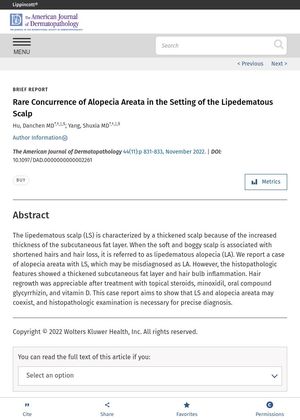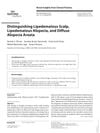Rare Concurrence of Alopecia Areata in the Setting of the Lipedematous Scalp
September 2022
in “
The American journal of dermatopathology/American journal of dermatopathology
”

TLDR A patient with a thick scalp and hair loss was correctly diagnosed with alopecia areata and a thick scalp fat layer, not lipedematous alopecia, and regrew hair after treatment.
The document discusses a case of alopecia areata occurring alongside lipedematous scalp (LS), a condition characterized by a thickened scalp due to an increased subcutaneous fat layer. This combination can be misdiagnosed as lipedematous alopecia (LA), which involves hair loss and shortened hairs. However, histopathologic examination revealed a thickened subcutaneous fat layer and hair bulb inflammation, distinguishing it from LA. The patient's hair regrowth was noticeable after treatment with topical steroids, minoxidil, oral compound glycyrrhizin, and vitamin D. The report emphasizes that LS and alopecia areata can coexist, and accurate diagnosis requires histopathologic examination.
